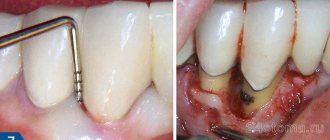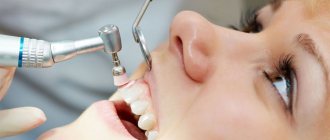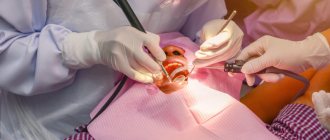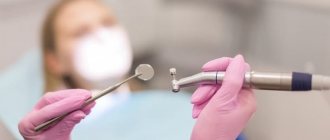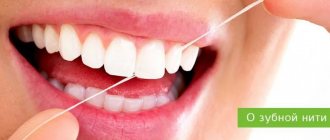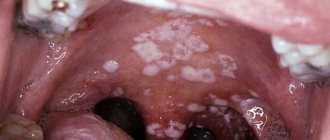May 22, 2020
An increasing number of people are convinced that professional teeth cleaning at the dentist, which should be done several times a year, helps keep teeth in order and helps prevent oral diseases. But doctors warn that good results can only be obtained when hygiene is carried out in a comprehensive manner. What stages should it consist of? Not everyone knows about this, so journalists from the editorial office of the UltraSmile.ru portal offer to examine the issue in detail in today’s material.
Stage No. 1. Preparation
First, the doctor prepares the patient for professional cleaning. The specialist conducts a short survey and then examines the oral cavity to identify any contraindications and assess the clinical situation. At this stage, it is very important to establish whether the patient is allergic to the components of the drugs that will be used during the procedure and to local “freezing”, whether there is asthma, breathing problems, or chronic diseases.
The doctor also needs to understand whether there are crowns, dentures, implants, fillings in the mouth, and whether there are non-carious defects and inflammations on the mucous membrane. It is important for women to tell their doctor if they are pregnant. Depending on the clinical situation and related factors, the doctor will regulate the force of the devices used and select the appropriate means to ensure hygiene is carried out in the most gentle, safe and effective manner.
Before the procedure, the patient is put on a special cap and protective glasses.
Next, the patient is given a special cap and protective glasses, which must be put on before brushing their teeth. You need to know that this is a procedure during which splashes and powder may come into contact with your face, hair and clothes. Therefore, try to come to it in the most simple and comfortable clothes, without complex makeup and intricate hairstyle, so as not to be upset later.
What is professional teeth cleaning? This is a set of measures aimed at removing all types of plaque from the enamel and from under the gums. As a result, the natural color and healthy shine of the enamel returns, bad breath goes away, and teeth and gums become stronger.
Before the procedure, many people wonder whether it hurts to have professional teeth cleaning done. We hasten to please you: it is not painful, since at the preparation stage the specialist will treat the oral cavity with a special anesthetic gel.
The most frequently asked questions from patients about the procedure
How painful is it?
(click to expand) Ultrasound teeth cleaning is a painless procedure, but it may be accompanied by minor discomfort in the presence of subgingival dental deposits - to remove them you need to slightly disturb the gums. Patients with increased sensitivity of the enamel may also complain of pain. In such cases, the doctor will perform cleaning with maximum comfort for the patient, using local anesthesia.
Is ultrasonic cleaning whitening? (click to expand) No, whitening is a completely different procedure, it is carried out using special whitening compounds that are applied to the tooth. A slight lightening of the enamel is due to the fact that after ultrasonic cleaning, the surface of the teeth is polished; sometimes the difference in color is clearly visible.
Is it true that plaque appears on teeth faster after ultrasonic cleaning? (click to expand) No, that's not true. On the contrary, after ultrasonic cleaning followed by polishing the enamel, plaque appears more slowly. Maintaining oral hygiene helps prevent its occurrence: responsible brushing of teeth at least 2 times a day, rinsing the mouth after meals, choosing the right toothpaste. Smoking, excessive consumption of tea and coffee, and metabolic disorders in the body contribute to the rapid appearance of plaque.
Can cleaning damage the enamel? (click to expand) If the procedure is carried out correctly, damage to tooth enamel is excluded. After cleaning, weak and thin enamel is additionally strengthened with remineralizing gels, the enamel is actively saturated with microelements, and it becomes stronger.
What should I do if I have an acute inflammatory process on my gums? (click to expand) Acute inflammation of the gums, accompanied by bleeding, in most cases is a contraindication to ultrasonic teeth cleaning until acute symptoms are relieved. We offer our patients tartar removal simultaneously with gum treatment using the Vector device. This is a specially designed ultrasonic scaler that is equipped with a unique Paro tip that creates special ultrasonic vibrations. The device allows for deeper treatment of periodontal pockets if the patient is diagnosed with periodontitis; Simultaneously with the removal of dental plaque, the enamel is polished with a special polishing liquid. After its use, supragingival and subgingival deposits, inflammation of soft tissues and bleeding are completely eliminated, bad breath disappears, and oral health is restored.
Is the procedure allowed during pregnancy? (click to expand) Ultrasonic teeth cleaning is not only allowed for pregnant women, but is also recommended for mandatory use. This is explained by the frequent occurrence of problems with teeth and gums in pregnant women due to hormonal changes and the need to sanitize the oral cavity before childbirth. The procedure is completely safe for the health of the expectant mother and her baby, but you still need to consult a gynecologist before performing it.
How often should you resort to ultrasonic teeth cleaning? (click to expand) We recommend that our patients have their teeth cleaned with ultrasound every 6-12 months; sometimes, if there is an increased tendency to form plaque, cleaning is done more often. The best solution is to carry out a comprehensive oral hygiene cleaning, which helps maintain oral health and fresh breath.
Ultrasonic teeth cleaning helps prevent the development of many dental diseases, so do not neglect this procedure.
Stage No. 2. Removal of hard dental plaque with ultrasound
The examination was carried out, the glasses were put on, the “freezing” began to take effect. Now what? The doctor begins cleaning your teeth using an ultrasonic scaler (scaler or scaler). The photo shows how this happens.
The photo shows an ultrasonic scaler
The specialist brings the tip of the device to the areas being treated, but does not touch them, that is, cleaning is carried out without contact. Microvibrations pass through the tip, which affect hard deposits, cause them to move away from the teeth and literally crush the stone into many small particles. In parallel with ultrasound, water is supplied to the oral cavity, cooling the enamel and preventing the risk of overheating, as well as washing away deposits that have lagged behind hard tissues.
Read the article on the topic “7 problems that professional teeth cleaning can solve.”
Some clinics may offer you laser treatment instead of ultrasound treatment. This is considered safer and more gentle. In addition, the laser does not cause any discomfort at all and additionally disinfects the oral cavity. But using a laser is more expensive.
Laser therapy method for teeth cleaning
The laser therapy technique is the most modern today. Its effect is based on the evaporation of liquid. The fact is that there is much more of it in plaque and tartar than in enamel. The laser, evaporating liquid from deposits, allows you to destroy the stones layer by layer.
Hygienic cleaning of teeth with a laser is carried out at a distance, without contact of instruments with oral tissues. Thus, this technique is completely painless. When it is carried out, there is no chance of infection, and the laser itself has an antiseptic effect.
Another advantage of laser cleaning at the dentist is that it helps to further whiten the enamel. Thanks to this, there is no need for another procedure. In addition, the light flux has a bactericidal effect and effectively fights pathogenic microorganisms, helps in the regeneration of wounds and prevents the development of caries. The entire procedure does not require any special preparations and is painless for the patient.
Laser teeth cleaning is contraindicated under the following conditions:
- Rhinitis and ARVI;
- The presence of implants, including pacemakers, in the patient’s body;
- Severe infectious diseases (HIV infection, tuberculosis, hepatitis);
- The presence of orthopedic structures in the oral cavity;
- The patient has a history of epilepsy and asthmatic attacks.
Stage No. 3. Removing soft deposits using Air-Flow
Doctors say that it is brushing teeth using the Air-Flow water-abrasive technology that makes it possible to lighten the enamel by 1-2 tones and polish it. Don't believe me? See before and after photos. The result is obvious! "Air-Flo" fights soft pigmented deposits formed after eating food and drinks with dyes, with a smoker's plaque. After the procedure, the teeth acquire their natural shade, become smooth and shiny.
The photo shows teeth before and after cleaning with the Air-Flow system
The procedure can be performed without ultrasound, but when combined with it, it is much more effective. To carry it out, you need a device into which a special fine soda-based powder is filled, as well as water. While performing Air-Flow, some patients report a feeling of slight coolness in their mouth. After Air-Flo, the unpleasant odor disappears, and your breath becomes fresh, since the powder contains different flavors (mint, cherry, peach, lemon).
Read the article on the topic “6 interesting facts about Air-Flow whitening.”
What is ultrasonic teeth cleaning and how is it done?
Ultrasonic teeth cleaning is, as the name suggests, a method that involves cleaning the oral cavity using ultrasonic waves. By their nature, these waves are the same as those in an ultrasound diagnostic device, but their parameters are slightly changed. Removal of hard and soft dental plaque occurs due to high-frequency vibration, which is created by ultrasound. The doctor can set different frequencies and amplitudes of radiation, thereby selecting the optimal mode of exposure, which will help clean the patient’s oral cavity with the highest quality possible. The effect is only on dental plaque, tooth enamel is not damaged in any way, which makes the procedure not only effective, but also safe.
The procedure begins with an examination of the oral cavity. The dentist identifies possible contraindications, determines the sensitivity of teeth and gums, and, if necessary, performs local anesthesia. After this, the procedure itself begins, which is performed in a certain sequence:
- Application of a special gel that provides better conduction of ultrasonic waves.
- Treatment of dental plaque with an ultrasonic scaler.
- Additional cleaning using the Air Flow method.
- Application of protective and mineralizing compounds.
Professional hygiene must be performed at least once a year, and best of all – every six months. As a result, it will be possible to maintain the oral cavity properly clean, if you do not forget about regular and proper hygiene at home.
Often on forums you can find reviews before and after ultrasonic teeth cleaning, in which patients complain of pain or insufficient effectiveness of the method. Such situations arise in cases where the procedure is carried out by an inexperienced specialist using outdated equipment. To avoid such unpleasant situations, you need to contact certified dental clinics that have all the necessary modern equipment and experienced staff who know all the nuances of the method, as in dentistry Zuub.rf. You can make an appointment and find out the address either by phone or on the clinic’s website. Keep an eye on promotions, this is a real saving of your money.
Stage No. 4. Cleaning subgingival deposits with hand instruments
This stage is not for everyone, but only for those who have a large amount of plaque under their gums. This usually happens if a person rarely undergoes professional teeth cleaning or has never had one in his life and does not know what it is. Or when a patient has periodontitis and periodontal disease, accompanied by the formation of deep periodontal pockets (the gums peel off from the teeth) and the rapid accumulation of abundant bacterial deposits in them.
With closed curettage, periodontal pockets are cleaned with special hooks
The procedure is performed manually using special devices called curettes. Curettes are hand-held instruments with a hook at the end. With their help, the doctor mechanically removes deposits that could not be removed with ultrasound and Air-Flo. There are several methods of curettage - open and closed.
Why do you need professional teeth cleaning at the dentist?
Dental plaque is the deposition of food debris and microorganisms on the surface of the enamel. Over time, soft plaque mineralizes and turns into tartar, which is very difficult to remove without the help of a dentist. The types of dental plaque described above are a source of bad breath, reduce the aesthetics of a smile and contribute to the development of the following diseases:
- Caries. Characterized by destruction of hard tooth tissues followed by inflammation of dentin and pulp. It develops under the influence of complex factors, among which bacteria, environmental pH, duration of exposure, etc. are important. Regular visits to the dentist and professional teeth cleaning can eliminate the described factors and thereby reduce the risk of caries.
- Gingivitis. Inflammatory gum disease that develops as a result of poor oral hygiene. During their life, bacteria release products that negatively affect the condition of the gums, causing inflammation and bleeding. Regular oral hygiene and periodic professional cleanings will help avoid these problems.
- Periodontitis. It is a consequence of untreated gingivitis and is characterized by the formation of periodontal pockets between the gum and tooth. Soft plaque and tartar continue to accumulate in these pockets, leading to the progression of the disease. In the later stages, significant exposure of the neck of the tooth root and pronounced mobility are observed. Treatment of periodontitis is long and complex and does not always give the desired result.
Ultrasonic teeth cleaning is not only a way to prevent diseases. Very often, the technique is performed before the start of various types of dental treatment. In such cases, the procedure will increase efficiency and avoid the development of serious complications. For example, pre-cleaning the tooth surface ensures stronger contact with filling materials, so the installed filling will last longer. When installing implants, professional teeth cleaning is especially important, as it avoids infection with subsequent inflammation and implant rejection.
Stage No. 5. Polishing the enamel
In order for professional teeth cleaning to be truly effective, and for the difference between what happened before and what happened after to remain as long as possible, it is necessary to carry out the enamel polishing stage. Why is it important? The structure of the enamel is heterogeneous and porous; it contains all sorts of cracks and microcavities into which bacteria and pigment can easily penetrate. After ultrasound and Air-Flo, the enamel again loses its protective film and acquires roughness, which becomes a favorable environment1 for the re-accumulation of plaque. They need to be eliminated. If you do not make hard tissues smooth, they will quickly begin to attract and collect soft food deposits, bacteria, and food dyes.
“I have never done prof. brushing my teeth, and two years ago I decided to do it for the first time. I got excited overnight and therefore went to literally the first doctor I saw. And what do you think? After just six months, I realized that the situation before was even better than it was after! During this time, I accumulated as much plaque as I had never had in my entire life before!!!! Then, of course, it turned out that I ended up with a not very good doctor, who really gave up on polishing, and this is a very important stage. I had the cleaning done again by another specialist, with good reviews, and, you know, I was satisfied.”
Darina, fragment of a review from the dental portal gidpozubam.ru
Polishing is also necessary if the patient has fillings and composite restorations in the mouth, because they also become porous over time and can move away from the tissues of the living tooth.
The range of measures includes polishing tooth enamel
To polish the lateral and chewing surfaces, specialists use a special brush with a rotating head, as well as a paste that is selected depending on the condition of the oral cavity and the characteristics of the patient.
Stage No. 6. Strengthening hard tissues
After professional teeth cleaning, doctors perform fluoridation. What it is? A product containing fluorine is applied to the enamel, which is necessary to strengthen hard tissues, prevent hyperesthesia (hypersensitivity), and prevent dental diseases (in particular, caries).
Fluoride varnish creates a thin protective film on the surface of the teeth, but the drug needs time to adhere. Therefore, immediately after the procedure, you should not drink for half an hour or eat for an hour, and it is also not recommended to brush your teeth for 12 hours.
Fluoridation will help strengthen tooth enamel
Dentists' tips for caring for your teeth after a comprehensive cleaning
It is in the patient’s interests that the effect of the complex of procedures lasts as long as possible. Therefore, it is important to follow the following recommendations from your dentist in the first few days:
- do not eat or drink for 2 hours after visiting the dentist;
- You should brush your teeth for 3–5 minutes after each meal and at night;
- possible increase in enamel sensitivity. Do not consume food or drinks that are too hot or too cold;
- try not to smoke, tobacco tars eat into the enamel very quickly;
- Reduce (or eliminate) from your diet foods and drinks that contain high amounts of natural and artificial coloring substances.
The dental network offers comprehensive teeth cleaning services. Our clinic offers family and savings discounts. Doctors are highly qualified and improve their skills in leading dental clinics in Russia and Europe. The level of services provided meets international standards.
Branches of our orthodontic center are located in Moscow within walking distance from the metro:
- Art. Alekseevskaya (VDNKh district, etc. Mira), address: st. 3rd Mytishchiskaya house 3, building 2;
- Art. Shelepikha, address: Shelepikhinskaya embankment, address: building 34, building 1.
We will make your teeth strong, beautiful and healthy! Come and see for yourself.
Rehabilitation after professional hygiene is another important home stage
What rules should you follow at home:
- avoidance of hard, hot, acidic and coloring foods in the first 2 days after the procedure. Now you know the answer to the question of whether brushing your teeth hurts. No, it is not painful, but after the procedure the enamel and mucous membranes may be sensitive and susceptible to any impact. Following this rule will help reduce the level of discomfort. In addition, this will allow the fluoride compound applied to the teeth to strengthen,
- changing the brush: the old one contains bacteria, and if you start brushing your teeth with it, the pathogens will easily migrate back into the plaque-free oral cavity,
- purchasing an irrigator and floss: these devices perfectly remove plaque from interdental spaces and hard-to-reach areas where a regular brush cannot reach,
Using an irrigator will help maintain the achieved result. - the use of remineralizing and restoring gum paste: the hygienist will definitely advise what exactly you need to purchase specifically in your clinical case. Pastes with minerals help reduce the sensitivity of enamel and help hard tissues quickly restore their natural protective film, which is removed along with plaque during comprehensive cleaning.
Some patients believe that teeth cleaning is a procedure that allows you to get rid of plaque and tartar forever. Actually this is not true. Deposits can build up again very quickly if you do not follow basic hygiene rules.
Notice
: Undefined variable: post_id in
/home/c/ch75405/public_html/wp-content/themes/UltraSmile/single-item.php
on line
45 Notice
: Undefined variable: full in
/home/c/ch75405/public_html/wp-content /themes/UltraSmile/single-item.php
on line
46
Rate this article:
( 2 ratings, average: 5.00 out of 5)
prevention
- Mikheeva E.A., Nesterova M.M. Smoothing and polishing the surface of the tooth bark as the final stage of professional teeth cleaning // Bulletin of the Smolensk State Medical Academy. – 2010.
Expert “Many doctors complete the complex of professional oral hygiene with a procedure such as fluoridation. This is not enough, because after cleaning it is important to restore and strengthen not only hard tissues, but also gums. For these purposes, it is necessary to use regenerating gels and membranes with plant extracts to restore the mucosa. Today, without this, professional hygiene cannot be considered complete.” Dental hygienist Victoria Nikolaevna Kashaeva
Consulting specialist
Kashaeva Victoria Nikolaevna
Specialization: Dental hygienist Experience: 8 years
Comments
But I’ll put implants in place of my teeth and won’t have to do any cleaning!
Artemy (06.06.2020 at 11:53) Reply to comment
- Dear Artemy, this will surprise you, but if you have implants and dentures, professional oral hygiene is also mandatory. In this case, the procedure must be carried out no less often than if you have natural teeth. Don't forget that the health of your implants largely depends on your oral health. If there is inflammation in the mouth caused by bacterial plaque (and it forms even when there are no teeth, on the gums and dentures), then the implants may be rejected.
Editorial staff of the portal UltraSmile.ru (06/14/2020 at 09:15) Reply to comment
At what age can a child have a brushing?
Natalya (06.28.2020 at 16:54) Reply to comment
- Dear Natalya, professional cleaning can begin when the child reaches the age of 3 years. True, for children the procedure is carried out slightly differently than for adults, using a special brush and paste. “Air-Flo” with a special finely abrasive and gentle powder can be used from 6 years of age, ultrasound – from 14 years.
Editorial staff of the portal UltraSmile.ru (07/01/2020 at 09:05) Reply to comment
